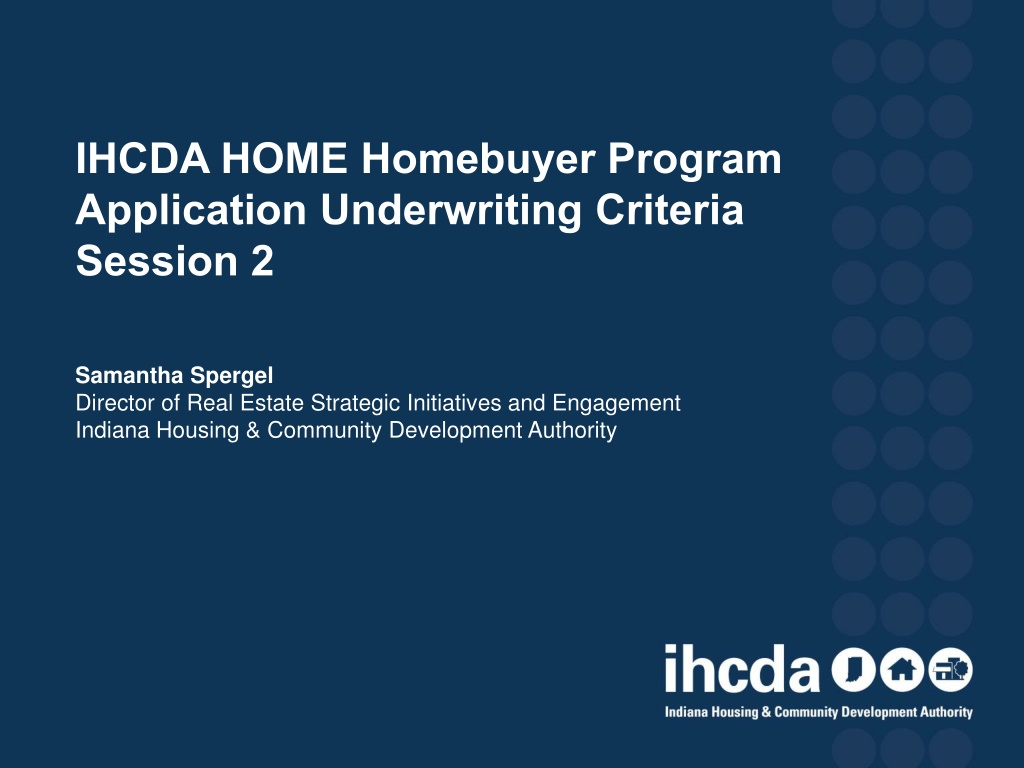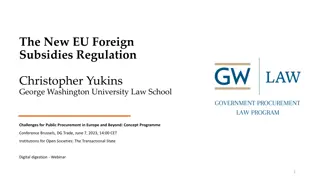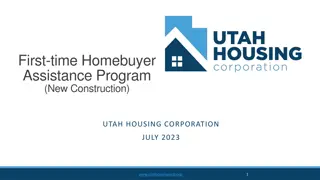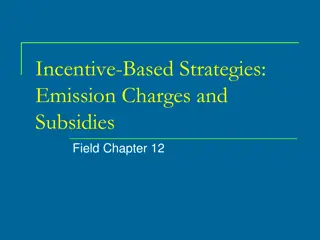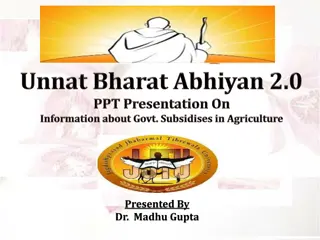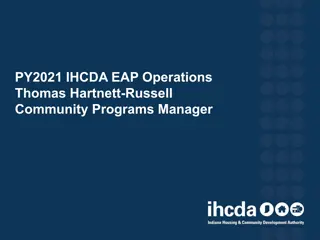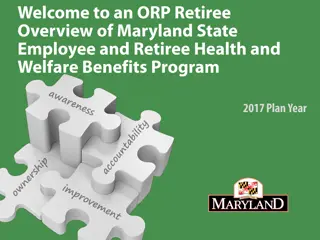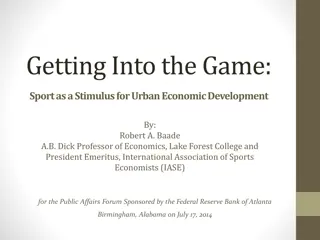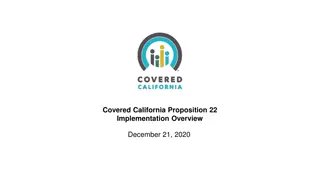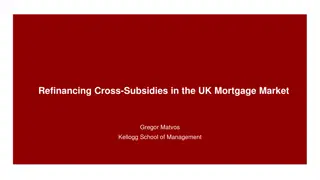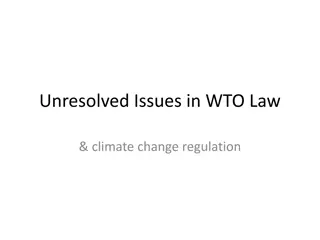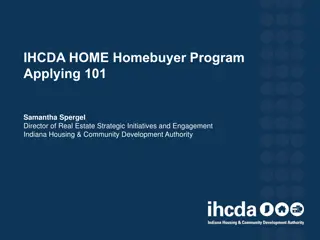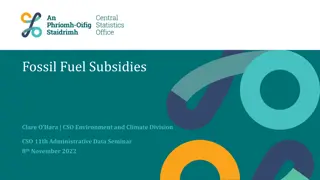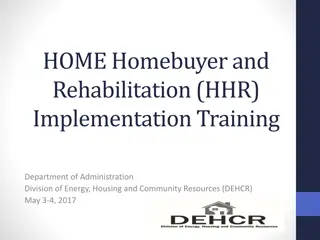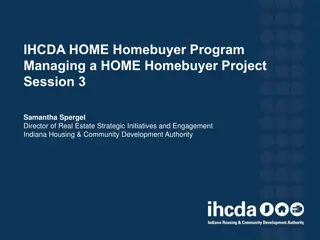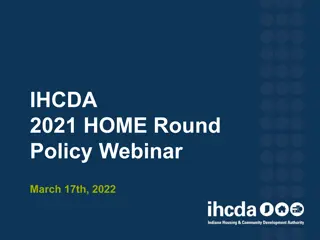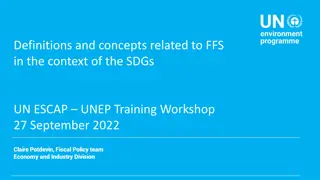Understanding IHCDA HOME Homebuyer Subsidies Program
Explore the Homebuyer Subsidies Program offered by the Indiana Housing & Community Development Authority (IHCDA). Learn about the three key subsidies available - Developer Subsidy, Buyer Subsidy, and Interim Construction Financing. Discover how these subsidies bridge the gap in development costs, promote affordability for buyers, and provide financing for homebuyer projects. Dive into the session insights shared by Samantha Spergel, Director of Real Estate Strategic Initiatives and Engagement at IHCDA.
Download Presentation

Please find below an Image/Link to download the presentation.
The content on the website is provided AS IS for your information and personal use only. It may not be sold, licensed, or shared on other websites without obtaining consent from the author. Download presentation by click this link. If you encounter any issues during the download, it is possible that the publisher has removed the file from their server.
E N D
Presentation Transcript
IHCDA HOME Homebuyer Program Application Underwriting Criteria Session 2 Samantha Spergel Director of Real Estate Strategic Initiatives and Engagement Indiana Housing & Community Development Authority
IHCDAs Mission and Vision Our Mission To provide housing opportunities, promote self-sufficiency, and strengthen communities. Our Vision An Indiana with a sustainable quality of life for all Hoosiers in the community of their choice.
Agenda What are the subsidies? Resale and Recapture Abridged Development Uses Buyer Purchasing Power Development Sources Breaking Down the Commitment Proforma
What are the HOME Homebuyer Subsidies?
Three Subsidies 1. Developer Subsidy 2. Buyer Subsidy 3. Interim Construction Financing
Developer Subsidy Developer subsidy is the difference between Total Development Cost and Market Value This is called the Appraisal Gap HOME can be used as a grant from IHCDA to the Developer to cover the difference when TDC > Market Value; no expectation from IHCDA of repayment (washed away) Cost over value may be driven by: Failed/Distressed market Inefficient scale of development Cost of to ensure federal compliance
Buyer Subsidy Called the Affordability Gap HOME provided to the buyer as a forgivable loan, including down payment or closing costs While eligible, want to generally avoid a reduction in sales price below market value
Interim Construction Financing 0% Loan from IHCDA to Developer to cover capital cost gaps for homebuyer projects Used when the developer does not have enough sources to cover the project Required under regulations to be repaid to IHCDA this is not a permanent contribution to the housing, unlike Developer Subsidy EXCEPTION: CHDOs! More on this later!
Recapture and Resale Abridged Version
Period of Affordability Period of Affordability (POA) is the required length of time the Lien and Restrictive Covenant (LRCA) is on the property. Type of lien, and length of time of the LRCA is based on if there is a Buyer Subsidy needed for the homebuyer. Different from HOME Rental in which POA is based on construction type.
Period of Affordability Subsidy of under $15,000 Five years Subsidy of $15,000-$40,000 Ten Years Subsidy of $40k or higher 15 Years
Recapture Sell to anyone, for any price but pay back the subsidy To use recapture, there must be direct assistance to the buyer i.e. Buyer Subsidy POA is then based on Buyer Subsidy only Generally POA length is between 5-15 years More on Recapture requirements in Sessions 4 and 5!
Resale Used when there is no Buyer Subsidy only Developer Subsidy and/or Interim Construction Financing POA based on TOTAL HOME award for unit POA length may be longer than just POA under Recapture Amount under LRCA will be higher More on Resale requirements in Sessions 4 and 5!
Breaking Down the Pro-Forma
Pro-Forma Two Pro-Forma worksheets: Commitment due with Application Closing due at least 3 weeks prior to closing Three Main sections: Development Uses Buyer Purchasing Power Development Sources Pro-forma must be completed by unit No such thing as a generic proforma
Development Costs and Budget
Sources or Uses first? Development Costs come first Be realistic and be complete Construction cost estimates must be included in application and reflected in Development Budget Include costs to develop AND sell units
Types of Uses Budget should include total costs for: Pre-development and Due Diligence Appraisals Architectural and Engineering Fees Recording Fees If rehab cost of Lead Inspection/Asbestos testing Professional Services Legal & Accounting Client Services Housing Counseling Income Verification Carrying & Financing costs Title Insurance for construction loans Builder s Risk/Liability insurance
Types of Uses Budget should include total costs for: Acquisition Land and Building Closing Costs at Acquisition NOTE: Remember that land value is based either on Purchase Agreement, As-Is Appraisal or Comparative Market Analysis (subject to IHCDA approval). Hard Construction Costs Residential Structures Free-standing accessory structures NOTE: not HOME eligible Appliances Contractor Contingency 5-7.5% must be budgeted for new construction projects 7.5-10% must be budgeted for rehabilitation Developer Fee cannot exceed 15% Final fee usually paid out of closing proceeds. Seller s Closing Costs Not HOME Eligible
Other Uses Considerations On-site infrastructure is eligible as a site improvement Underground utilities Connection to public lines Off-site infrastructure is NOT HOME-Eligible Extending public services to site, like sewer Units must meet HOME Property Standards Rehab: Useful life (5 years) this is MINIMUM. If in doubt, replace it! Lead Based Paint if pre-1978 Reasonable Accommodations Energy Efficiency Remember commitments of Universal Design, Green Building and Design Features
Cost Standards 2 CFR 200 Cost Principles apply; costs must be: Reasonable, necessary, allocable and documentable Must document all uses Every project is unique build your cost estimates from scratch Do not overlook, ignore or understate costs Budget conservatively Don t use lowest end of cost ranges
Preliminary Buyer Commitment Based on unknown, lowest achievable buyer profiles Closing Based on known buyer, individual analysis, reconciles to the closing statement Some may have buyers lined up but circumstances can change. Commitment section will estimate the amount of proposed buyer subsidy Must underwrite each unit and each buyer separately!
Determining Cash Needs Projected appraised value or Sales Price entered at top of pro-forma Add in the estimated closing costs or any pre-paid funds Allowable LTV: IHCDA recommends an LTV no higher an 95%; LTV can be no lower than 80%. Enter as percentage This will calculate the maximum projected mortgage based on the value, and the cash needed (DPA/closing cost assistance/buyer cash) for the projected closing.
Principle, PMI and Mortgage Estimated interest rate HFH will have 0% Mortgage Insurance Premium Rate: Enter projected PMI Will not apply to HFH Want to see if we can limit this Enter projected Mortgage term minimum is 20; cannot exceed 30-year term. Pro-forma will calculate projected mortgage payment
Understanding the Front-End Ratio Front-End Ratio indicates what portion of an individual's income is allocated to mortgage payments For these buyers, will also include taxes, insurance, utilities Does NOT include other non-housing debt. IHCDA uses 29% Front-End Ratio We can accept waivers to this with your application.
Buyer Profile You will identify the 50% AMI limit 4- person household for your county. See RED Notice 23-26 This does not limit you to that AMI, but shows you the suggested buyers AMI limits to ensure affordability for that buyer. Buyer must put in minimum of $250 toward purchase okay to go higher. Max Total Buyer Assistance is amount needed after projected buyer cash. This is projected Buyer subsidy for unit. Pro-forma will identify PITI.
Buyer Profile Buyer Subsidy: In 2023 policy, will allow buyer subsidy of up to $60k for households at or below 50% AMI 50-80% AMI cannot exceed $50,000 LTV may not be lower than 80% Higher Buyer Subsidy will mean longer POA homebuyer education is critical HFH Right of First Refusal not allowed during POA This is a tool to look at who should be in your buyer s pool.
Circling back on the subsidies Remember the three subsidies: Development Subsidy Homebuyer Subsidy Interim Financing Each of these will be calculated under the Development Sources section of the pro-forma
Total Development Costs Pro-Forma will pull TDC from Development Budget This example presumes no developer fee.
Development Subsidy Sources Pro-Forma will pull Gross Developer Subsidy. Other grants to be applied to the Developer subsidy include all those that are donated to the site. This can include: Donations/discounts (including volunteer labor) Waived Fees Philanthropic Support Public Funding Cash donations could count as equity and not be counted as part of Developer Subsidy
Interim Development Financing Interim Construction Financing is TDC (Development Subsidy + Buyer Subsidy + Costs paid from Sales proceeds) Think of this financing as proceeds that must be paid back. Habitat mortgage could be recorded as equity. Revolving cash donations that would go back to NFP can be noted as a loan.
How much HOME do I need? Putting it all together
Total HOME Investment Needed Development Subsidy of $50,000 Washed by IHCDA Buyer Subsidy of $35,750 Subject to Recapture and will have LRCA for 10 years Interim Financing of $39,250 Repayable to IHCDA within 30 days of closing to IHCDA unless CHDO Total HOME award of $125,000
HOME Request $125,000 would go under HOME request column under Development Budget Will assist IHCDA staff with setting up contract if project is approved by board Budget will go into contract and IHCDA Online
HOME Request Remember sources = uses Please note that HOME request is projection of actual costs and buyers. Closing Pro-forma will reassess proposed sales and final development numbers. Keep documentation of change of development costs, and other sources
Sales Price > TDC If sales price exceeds TDC, the unit is not eligible for developer subsidy. Pro-Forma will show negative Appraisal Gap Application is still eligible for Interim Construction Financing + Buyer Subsidy NOTE: Buyer Subsidy alone is not eligible
Upcoming Training Monday, August 28th 9:30am
Managing a HOME Homebuyer Project Cross-Sectional Regulations Section 3 Davis Bacon IHCDA Contract Process Inspection Policy Retainage Policy Extension Requests HOME timelines and deadlines Expenditure deadline De-obligation 9-month timeline
ANY QUESTIONS? Samantha Spergel, Director of Real Estate Strategic Initiatives and Engagement sspergel@ihcda.in.gov
